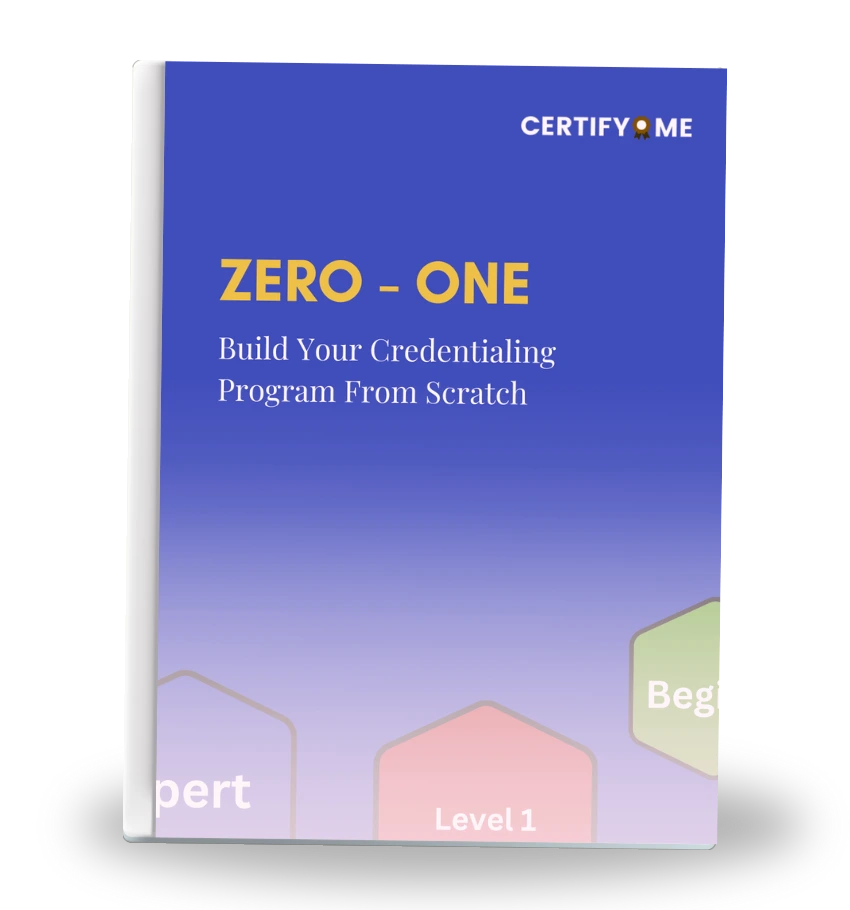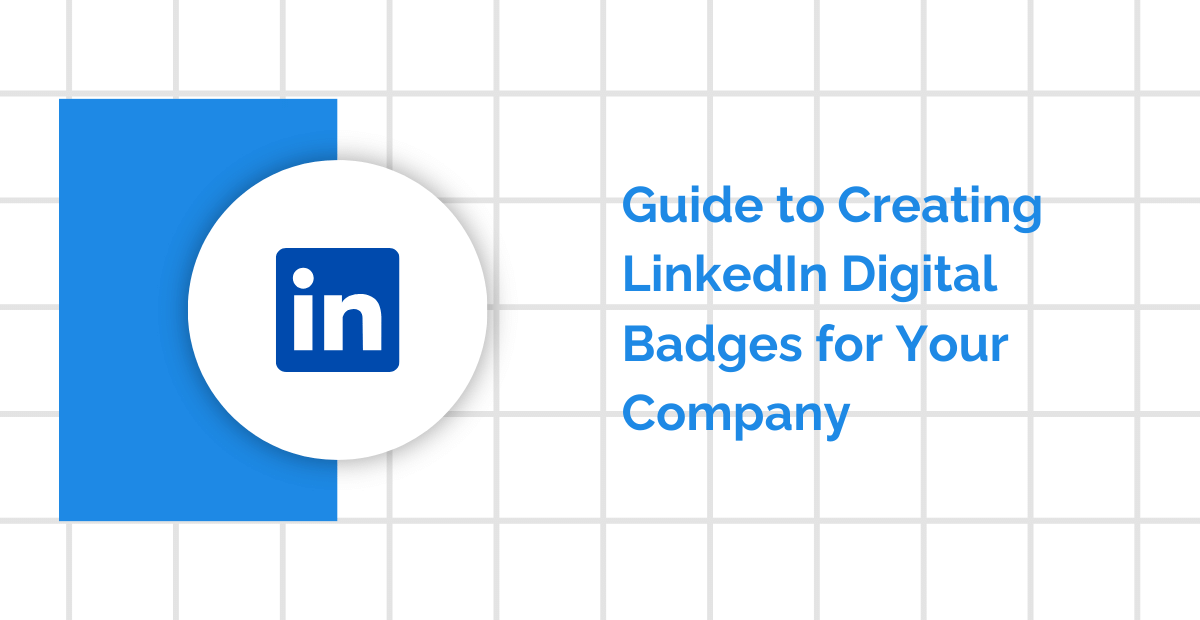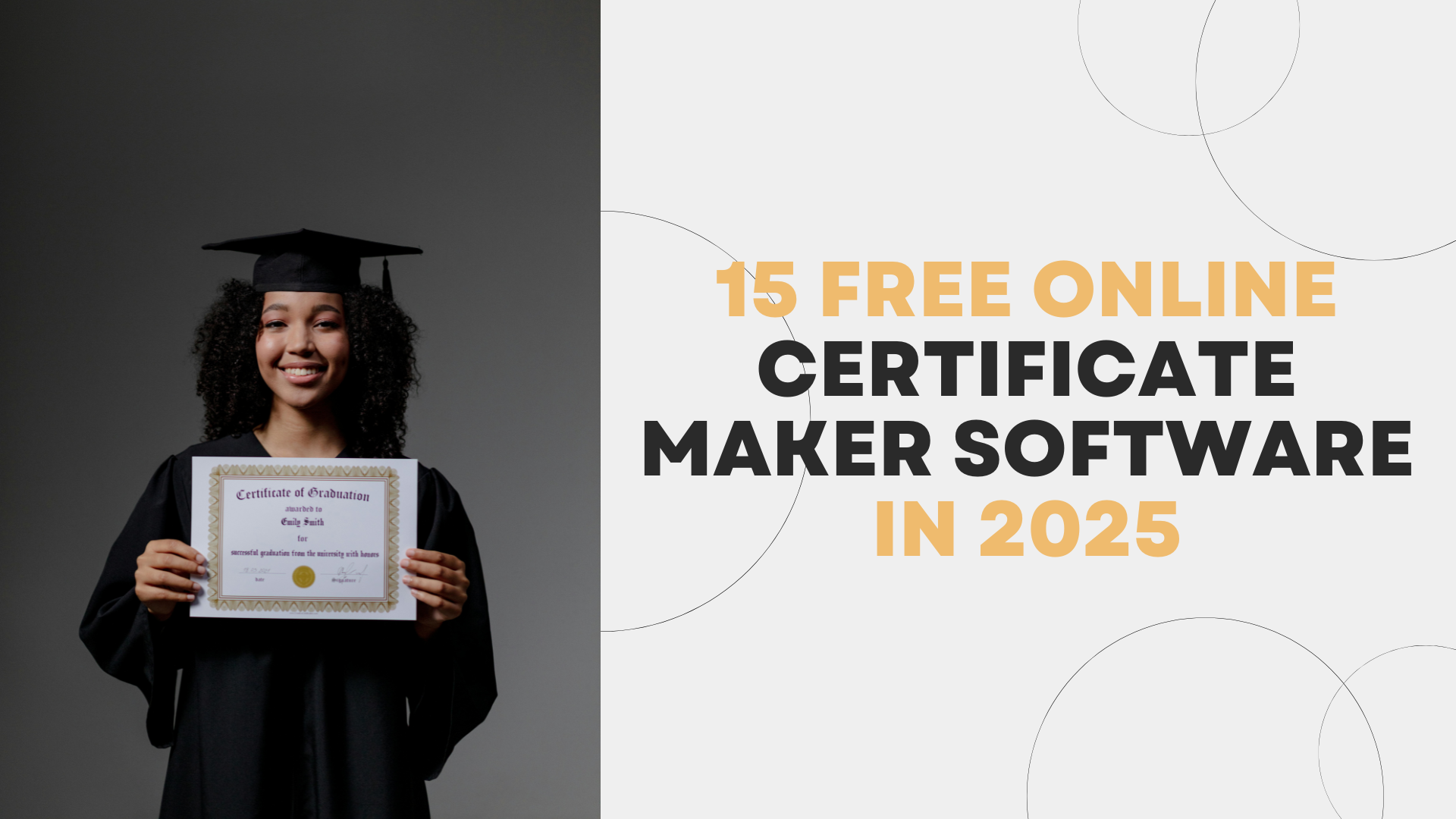A close friend of mine—let’s call him Mark—once showed up at a job interview with a folder full of documents. Somewhere in that folder was his degree certificate. Or so he thought. Turns out, he’d brought an older transcript by mistake. The actual certificate? Still lying safely in a dusty drawer back home. No big deal, right? Except he didn’t get the job.
That’s when he asked me, “Hey, do digital certificates really make things easier?”
Good question.
When it comes to credentials—your proof that you did something, earned something, or achieved something—the format matters more than most people think. And in today’s digital-first world, the shift from paper to digital isn’t just a trend. It’s a smart move.
So let’s break it down: Which is better—paper or digital certificates?
Let’s Break It Down—What Are We Comparing?
When you hear someone mention a certificate, you probably picture a formal sheet of paper—thick, slightly glossy, maybe with a ribbon or an embossed seal. It might be framed and hanging on a wall or folded into a dusty file in the back of your closet. That’s the traditional paper certificate. We’ve known it for decades, maybe even centuries.
But today, we’re in a different world. A world that moves fast, lives online, and communicates through screens more than paper. Enter digital certificates. They’re not just scanned copies of the paper version. They’re secure, shareable, and often interactive records of achievement, purpose-built for the digital age.
Let’s take a closer look at what we’re really comparing.
Not all digital certificates are created equal. Explore the most common types of digital certificates that students and universities are using today.
Paper Certificates: The Tangible Proof
Paper certificates have history on their side. They feel official, maybe even ceremonial. You hold them in your hands and, for many, that physical presence adds a sense of accomplishment.
But that’s where their advantages mostly end.
-
Storage can be tricky. You need a safe place—something moisture-free, flat, and private.
-
Sharing is slow. You need to scan or photograph the certificate to send it digitally, and the copy can look blurry or unofficial.
-
Verification takes time. If someone wants to check if your certificate is real, they usually need to call or email the issuing body.
-
The risk of forgery is real. With high-quality printers and graphic design software, creating fake paper credentials has become alarmingly easy.
In short, while paper certificates may feel prestigious, they’re not very functional in a world that values speed, accessibility, and security.
Digital Certificates: Credentials for the Connected World
Digital certificates, on the other hand, are created and issued entirely online. You earn a credential—say, for completing a course, attending a workshop, or pursuing a Cyber security Course and receive a digital file or link that proves it. That link usually leads to a certificate that’s stored on a secure platform and comes with embedded data: your name, the date, the organization that issued it, and even what you achieved.
They’re not just scanned copies of the paper version. They’re secure, shareable, and often interactive records of achievement, purpose-built for the digital age—learn more about what digital credentials really are.
Here’s what sets them apart:
-
They’re instantly accessible. As long as you have internet access, your certificate is just a few clicks away.
-
They’re built for sharing. Post them to LinkedIn, include them in your resume, or send them directly to an employer—all with a link.
-
They’re verifiable in seconds. Employers and universities can click on the link or scan a QR code to confirm it’s authentic.
-
They’re hard to fake. Many digital certificates are protected with blockchain or other tamper-proof technology, making forgery nearly impossible.
So while paper gives you something to hold, digital certificates give you something to use.
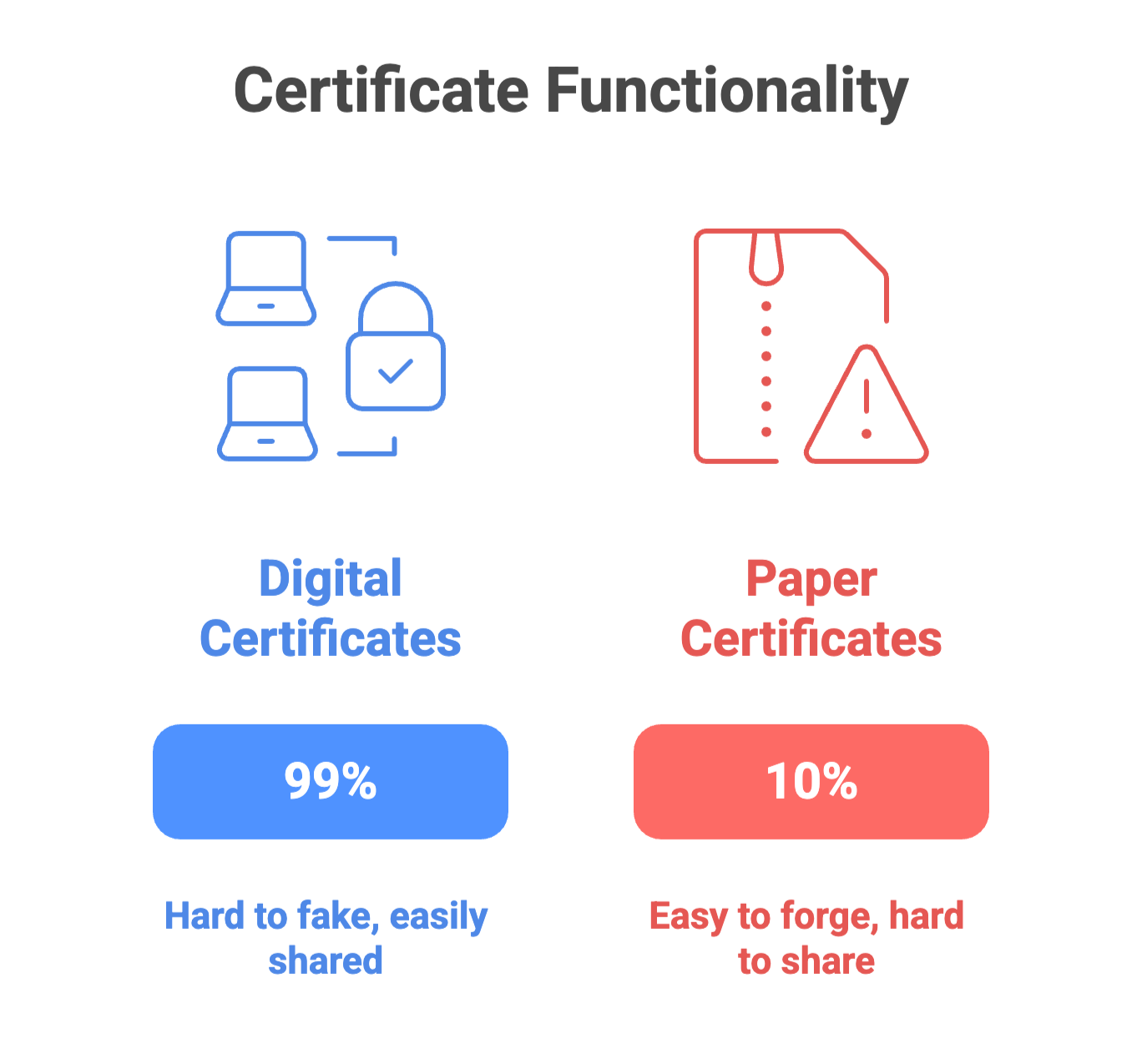
Bottom line? If your goal is to show proof of achievement in a way that’s easy, fast, and trusted, digital wins. But if you want something to frame for the wall in your study, paper still has a place. It’s not a competition of good vs. bad—it’s a matter of what works best in today’s context.
How Easy Are They to Store and Share?
Let’s face it—nobody loves keeping track of paperwork. If you’re like most people, your important documents live in a mismatched pile: a few tucked in your drawer, some in a plastic folder, and maybe one or two scanned copies lost in the depths of your email inbox. Certificates—especially paper ones—are no exception.
When it comes to storing and sharing credentials, the format you choose makes all the difference. Let’s explore how paper and digital stack up in the real world.
With Paper Certificates: A Storage Puzzle
There’s something undeniably satisfying about holding a certificate in your hands. But once the applause fades and the frame comes off the shelf, reality kicks in.
Where do you keep it? How do you share it? And what if you need it… right now?
Paper certificates present a few common issues:
-
They take up space. Not much, but enough that you have to dedicate a safe spot—a file, a drawer, or even a folder that travels with you.
-
They’re vulnerable to damage. Water, sunlight, or even a careless coffee spill can ruin years of hard work.
-
They’re easy to lose. Especially if you’ve moved, changed addresses, or reorganized your papers (again).
-
They require extra steps to share. You’ll need to scan or photograph them, then email or upload the image, hoping it’s readable and looks legit.
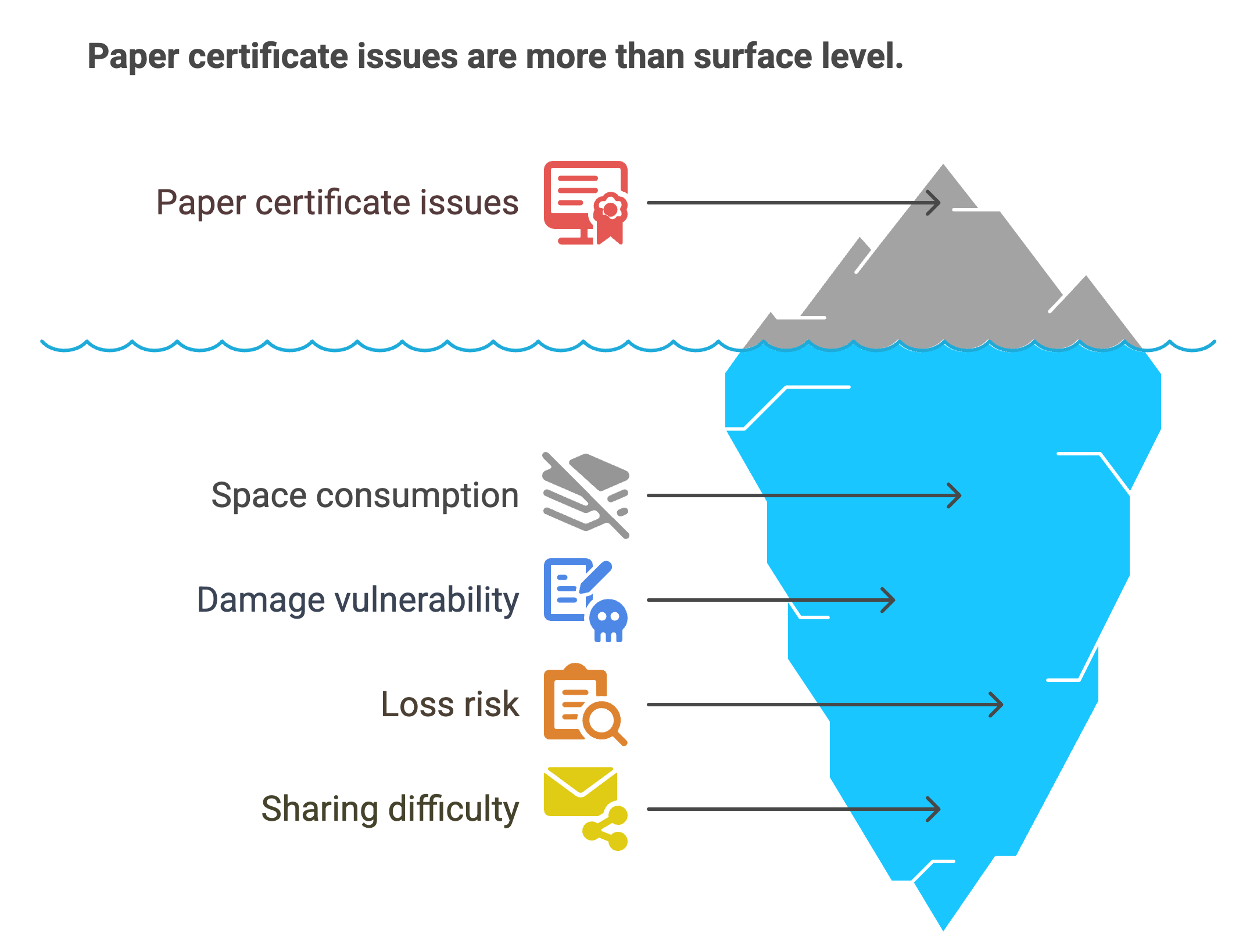
One student told me about scrambling to scan a certificate at a printing shop just minutes before an internship deadline—printer jammed, scanner glitched, and she barely made it. Sound familiar?
With Digital Certificates: Click, Send, Done
Now imagine this: you earn a credential, and minutes later, it’s in your inbox. No mailing delays. No lost papers. Just a secure link or a downloadable file you can access from your phone, tablet, or laptop—wherever you are.
Here’s what makes digital storage and sharing so convenient:
-
Cloud-Based Storage: You can save digital certificates to Google Drive, Dropbox, or even your email.
-
No Need for Scanners or Printers: You’re ready to share the moment you receive it.
-
One-Click Sharing: Whether it’s LinkedIn, a resume PDF, or a job portal, adding your certificate is as easy as copy-paste.
-
Professional Presentation: No wrinkles, blurs, or bad lighting from scanning. You send a clean, verified version every time.
-
Permanent Access: Lose your laptop? No problem. Your certificate still lives safely in the cloud. Many students link their digital certificates directly to their LinkedIn profiles. Here’s how you can do it.
Digital certificates are designed for the world we live in now—a world that’s mobile, connected, and always moving. Whether you’re applying for a job, a scholarship, or graduate
So next time you earn a certificate, ask yourself: Do I want something I have to protect… or something that protects me? For storage and sharing, digital doesn’t just win—it runs laps around paper.
Let’s Talk Trust—Can It Be Verified?
Let’s be honest—looks can be deceiving. A certificate might look official. It might even feel official. But unless there’s a way to verify it, it’s just a piece of paper with fancy fonts.
Trust is the bedrock of any credential. Whether you’re applying for a job, transferring schools, or submitting a license application, the person on the other end needs to believe that your certificate is real—and issued by a legitimate authority.
So, how does verification work? And how do paper and digital certificates compare when it comes to confirming what’s real and what’s not?
These tools are often part of advanced platforms or online certificate makers designed for ease, branding, and verification.
Verifying Paper Certificates
Traditionally, verifying a paper certificate means… well, doing it the old-fashioned way.
-
A registrar might need to dig into a filing cabinet or internal database.
-
An employer might need to call or email the university.
-
The process could take days—or even weeks.
Worse, the verification sometimes depends on human memory. Did the certificate actually go out? Was it signed correctly? Is there a backup copy?
And in today’s world, forgery is easier than ever. With decent design skills and a printer, someone could whip up a fake degree that looks strikingly real. For employers, that’s a risk. For universities, it’s a liability.
Even when certificates are authentic, the time it takes to confirm them slows everything down—frustrating both students and staff alike.
Verifying Digital Certificates
Digital certificates flip this whole model on its head. They don’t rely on memory or paperwork. Instead, they prove themselves—in real time.
Most digital certificates today come with:
-
A unique verification link
-
A QR code
-
Cryptographic signatures
-
Or blockchain-backed credentials
That means an employer or official can click a link, scan a code, or check a platform—and instantly see:
-
Who issued the certificate
-
When it was issued
-
Who it was issued to
-
What the recipient accomplished
No phone calls. No follow-up emails. No digging through files.
Building Institutional Trust
For universities, offering verifiable credentials isn’t just convenient, it builds credibility.
It says:
“We stand by what we issue. We have nothing to hide. And we want others to trust our students.”
From a student’s point of view, that trust goes a long way. It can:
-
Make hiring managers more confident
-
Speed up application reviews
-
Help bypass lengthy background checks
With FERPA compliance in mind, many digital platforms ensure credentials remain private and secure. Learn more about FERPA protections.
Final Thought:
In a time when misinformation and fraud are everywhere, verification matters more than ever. Paper certificates leave too much room for doubt. Digital ones? They leave no question unanswered.
Speed, Cost, and Hassle—Who Wins?
Picture this: It’s graduation season. Thousands of students are getting their degrees, certificates, and awards. Behind the scenes, administrative staff are racing against the clock—printing, signing, sealing, and mailing out paper certificates, all while handling inquiries from students asking, “Did mine go out yet?”
This isn’t just a busy week—it’s an annual headache.
Now let’s take that same scenario and move it to the digital world.
In seconds, thousands of certificates can be generated, personalized, and emailed directly to recipients. No printers. No envelopes. No postage. No delays.
Time: The Cost No One Counts
Paper certificates are slow.
-
They need to be designed, printed, signed (often manually), and packaged.
-
They need to be mailed—sometimes locally, sometimes internationally.
-
If something goes wrong? That’s more time and more back-and-forth.
Even the most efficient registrar’s office can’t beat the speed of digital issuance.
Digital certificates are fast.
-
They can be generated and issue in batches, all from a simple digital credentialing service.
-
Delivered instantly to a student’s inbox
-
Accessible 24/7—no need to “wait for office hours”
Real Example: A university in Texas reduced their certificate issuance time from 7 days to 7 minutes by switching to a digital platform. The number of support emails? Dropped by 60%.
Cost: It Adds Up
Printing and mailing certificates might seem inexpensive at first glance. But add it up:
-
High-quality paper and ink
-
Printing equipment and maintenance
-
Envelopes, postage, and handling
-
Labor hours for sorting, signing, sealing
Multiply that by a few hundred—or a few thousand—students, and you’re staring at serious overhead.
Digital certificates, meanwhile, eliminate most of these expenses. You’ll likely pay a licensing fee for a digital platform, but the long-term savings are significant. You’re cutting out paper, postage, and manual labor. Plus, fewer errors mean fewer reprints and re-issues.
Bonus Benefit: Digital is also eco-friendly. No trees harmed. No carbon footprint from mailing paper across the globe.
The Hidden Hassles
Paper comes with more than just cost—it comes with logistical headaches:
-
Delayed mail
-
Lost or damaged certificates
-
Returned envelopes due to wrong addresses
-
Students needing urgent re-prints
For staff, it’s repetitive and draining. For students, it’s stressful and inconvenient.
Digital certificates remove these frictions. Once issued, they can be:
-
Downloaded
-
Re-sent
-
Re-verified
All without paperwork, queues, or phone calls.
For Institutions, It’s a No-Brainer
-
Want to reduce workload?
-
Want to issue faster and cheaper?
-
Want to give students a smoother experience?
Then digital wins across the board. It’s not just faster and cheaper—it’s smarter.
Want to give students a smoother experience? Learn how institutions can send digital certificates in bulk without breaking a sweat.
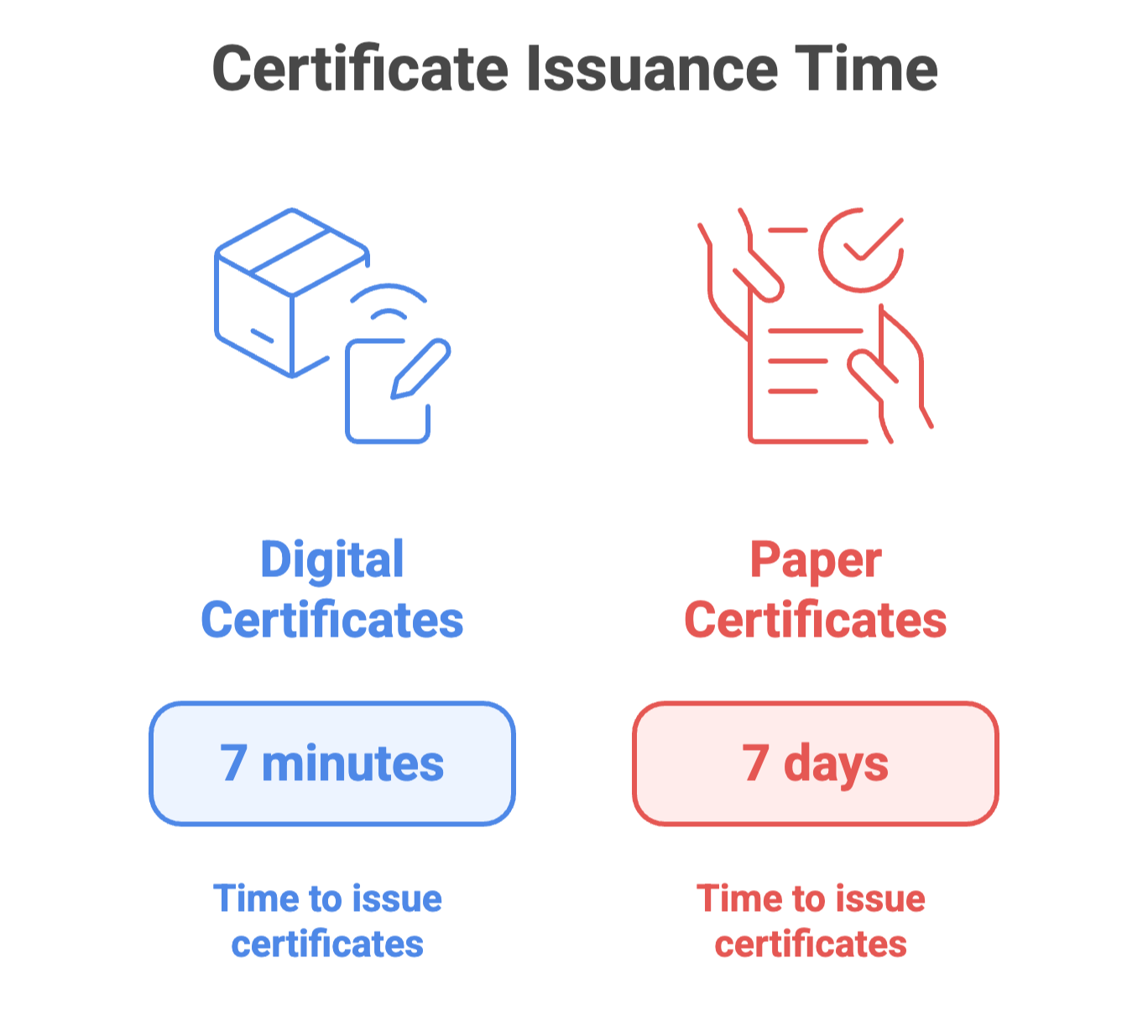
In 2025, where everything from banking to classrooms has gone online, clinging to paper certificates isn’t just inefficient—it’s outdated.
Are There Any Downsides to Going Digital?
Let’s be honest. Digital certificates aren’t perfect. But their shortcomings are fewer—and shrinking.
Possible Cons:
-
Not everyone is tech-savvy
-
Some employers or government agencies still ask for paper
-
Requires reliable internet and digital storage
But these issues are getting rarer every year. In fact, more organizations now prefer digital formats because they’re easier to verify.
Analogy: It’s like DVDs in a Netflix world. Sure, some people still use them—but most of us have moved on.
That said, hybrid models exist too. Some universities issue both paper and digital versions, giving students the best of both worlds.
Real-World Voices—What Students and Staff Say
You’ve seen the features. You’ve heard the arguments. But what does this all really look like on the ground? How do real students and university staff experience the shift from paper to digital?
Sometimes, the clearest answers come not from data sheets, but from everyday stories.
Student Voices:
-
Tanya, Graduate Student (Michigan):
“I moved to a different state after college and realized I had no clue where my paper degree was. It wasn’t a problem—until I needed to apply for grad school. Tracking it down and getting a reissue took weeks. Since then, every certification I’ve earned has been digital. I save them on Google Drive and share them in seconds.” -
Luis, Computer Science Major (California):
“I got a coding badge from a workshop last summer. The best part? I linked it to my LinkedIn profile and added it to my GitHub. When I interviewed for an internship, the recruiter mentioned it. I didn’t have to carry any files or explain what I did—they had the details right there.”
Students today don’t just want credentials. They want credentials that work for them. Ones they can pull up on a phone, attach to an email, or embed in a resume without jumping through hoops.
And it’s not just students noticing the difference.
Registrar and Staff Voices:
-
Jason, University Registrar (Ohio):
“When we were handling paper certificates, we had a small team but a massive mailing list. Graduation season used to mean long hours, printing jams, and anxious students calling about delivery dates. After we switched to digital, that pressure dropped. We now issue credentials in batches—and students receive them almost instantly.”
-
Marla, Administrative Assistant (New York):
“I used to spend a lot of time printing, scanning, and confirming receipt of paper certificates. Now, we use a dashboard that tracks every issued credential. If a student needs it resent, I click one button. Done. No printer. No stamps.”
Some institutions even take it a step further with white-labeled digital credentials, letting them maintain full brand control while simplifying delivery.
Their experiences show a recurring pattern—digital makes everyone’s life easier. Students feel more in control. Staff feel more efficient. And institutions project a modern, forward-thinking image.
Real-world feedback doesn’t just validate the digital option—it makes a compelling case for it.
Final Thoughts—What’s the Smart Choice Today?
Let’s step back.
We’re not asking whether paper certificates are bad. We’re asking what works better—not just in theory, but in real life.
Paper certificates have a certain charm. They’re ceremonial. They’re tactile. They hang beautifully in an office or a dorm room. For many, they symbolize years of effort and late-night study sessions.
But in today’s digital, fast-paced, always-on world… charm doesn’t cut it when:
-
You need to apply for a job within 24 hours
-
You’re submitting documents across borders
-
You’re proving your skills in a digital-first hiring process
And here’s the thing: digital doesn’t mean you lose the sense of achievement. You still earned that degree, badge, or certificate. The format is just more useful, accessible, and reliable.
If you’re a student, your credentials need to move as fast as you do.
If you’re a university staff member, your workflow deserves tools that make life simpler—not more paper-piled.
It’s not about choosing new over old.
It’s about choosing smart over slower.
We live in a world where everything else—banking, medical records, even our groceries—has gone digital. Why should our academic and professional credentials lag behind? Even the U.S. Department of Education emphasizes the value of digital solutions in modern learning. Explore their digital learning resources.
Call to Action
For Students:
The next time you finish a course, complete a workshop, or graduate, ask if a digital certificate is available.
If it is—use it.
-
Save it in the cloud
-
Add it to your LinkedIn
-
Include the link in your resume
Your future self will thank you when you’re applying for jobs, internships, or further education.
If your institution doesn’t offer digital certificates yet? Don’t be shy—ask for them. The more students push for modern solutions, the faster universities will adopt them.
For University Administrative Staff:
If you’re still issuing only paper certificates, now’s the time to consider the alternatives.
-
Talk to your IT team or academic services
-
Explore digital credential platforms
-
Run a pilot program with a small department
You don’t need to overhaul your entire system overnight. Even starting with digital copies for transcripts, diplomas, or skill-based badges can make a massive difference.
Remember: transitioning to digital isn’t about erasing tradition—it’s about evolving to better serve students and staff alike.
Quick Checklist: Is Your Institution Ready for Digital Credentials?
-
Do students frequently request re-issues of lost paper certificates?
-
Are your certificate processes manual, time-consuming, or expensive?
-
Do you get verification requests from employers that take days to fulfill?
-
Would your team benefit from automation and a simplified workflow?
If you answered yes to any of these… It might be time to go digital.
Conclusion
It’s clear by now that digital certificates aren’t just a trend—they’re simply a smarter way to manage credentials. Whether you’re a student juggling applications or a staff member handling piles of paper, going digital means less stress, faster access, and fewer mistakes. Paper still has its place, but it’s becoming more symbolic than practical. And in a world that lives online, practicality wins.
Think about it this way—if your achievements deserve to be seen, why let them sit in a drawer? A digital certificate moves with you, speaks for you, and can be shared with a click.
For students, it’s like carrying a verified resume in your pocket. For institutions, it’s an easier, cleaner way to serve thousands without drowning in admin work.
If you’re curious how this works in real life, CertifyMe makes it simple to issue, manage, and share digital certificates at scale—secure, verifiable, and ready to go whenever you are. Whether you’re part of a university or earning your next credential, it’s worth seeing how digital can fit into your world.
Take a look, ask questions, and if it sounds like a fit, book a quick demo call. You might be surprised how easy the switch can be.

 Author :
Author : 

